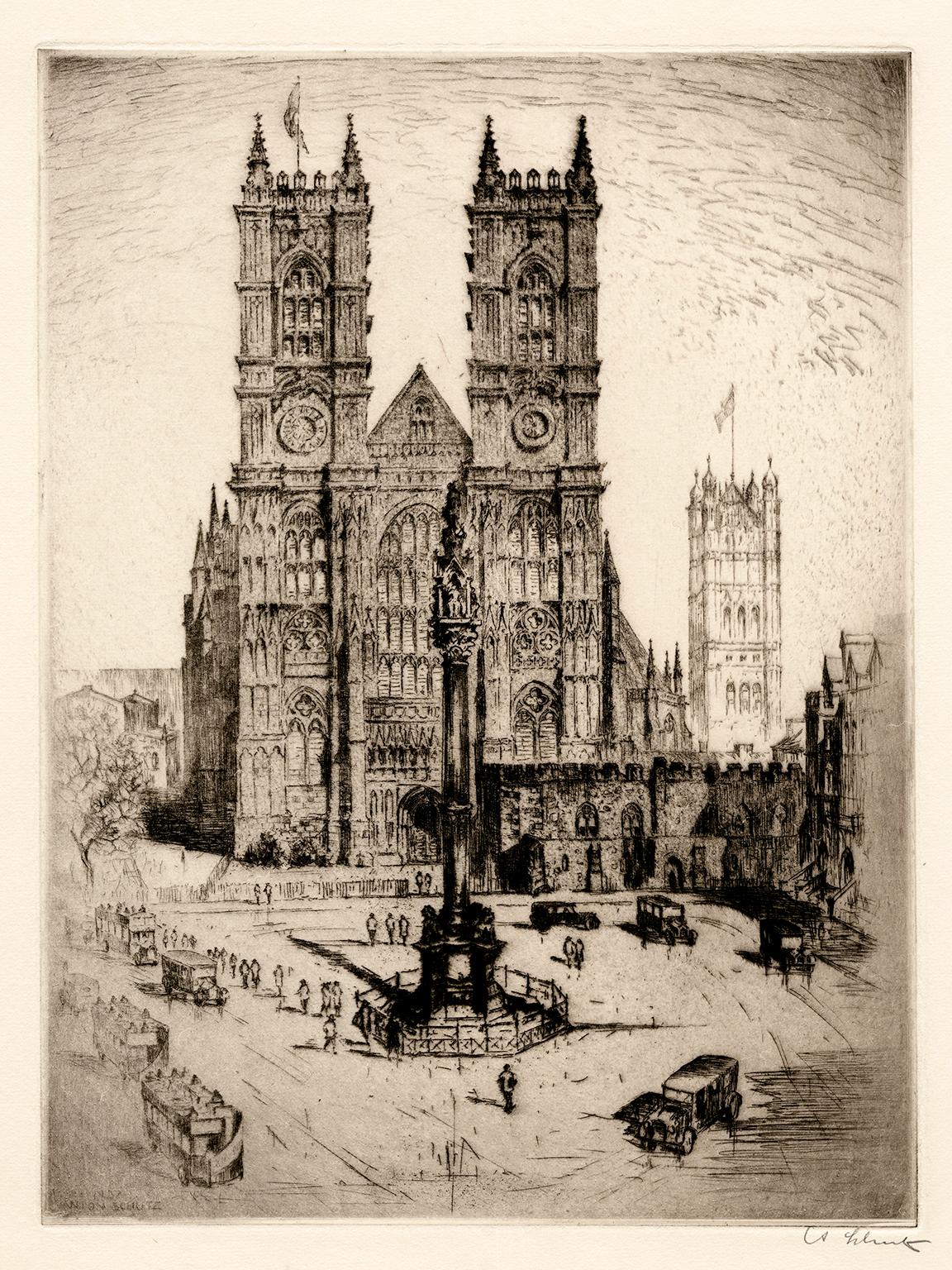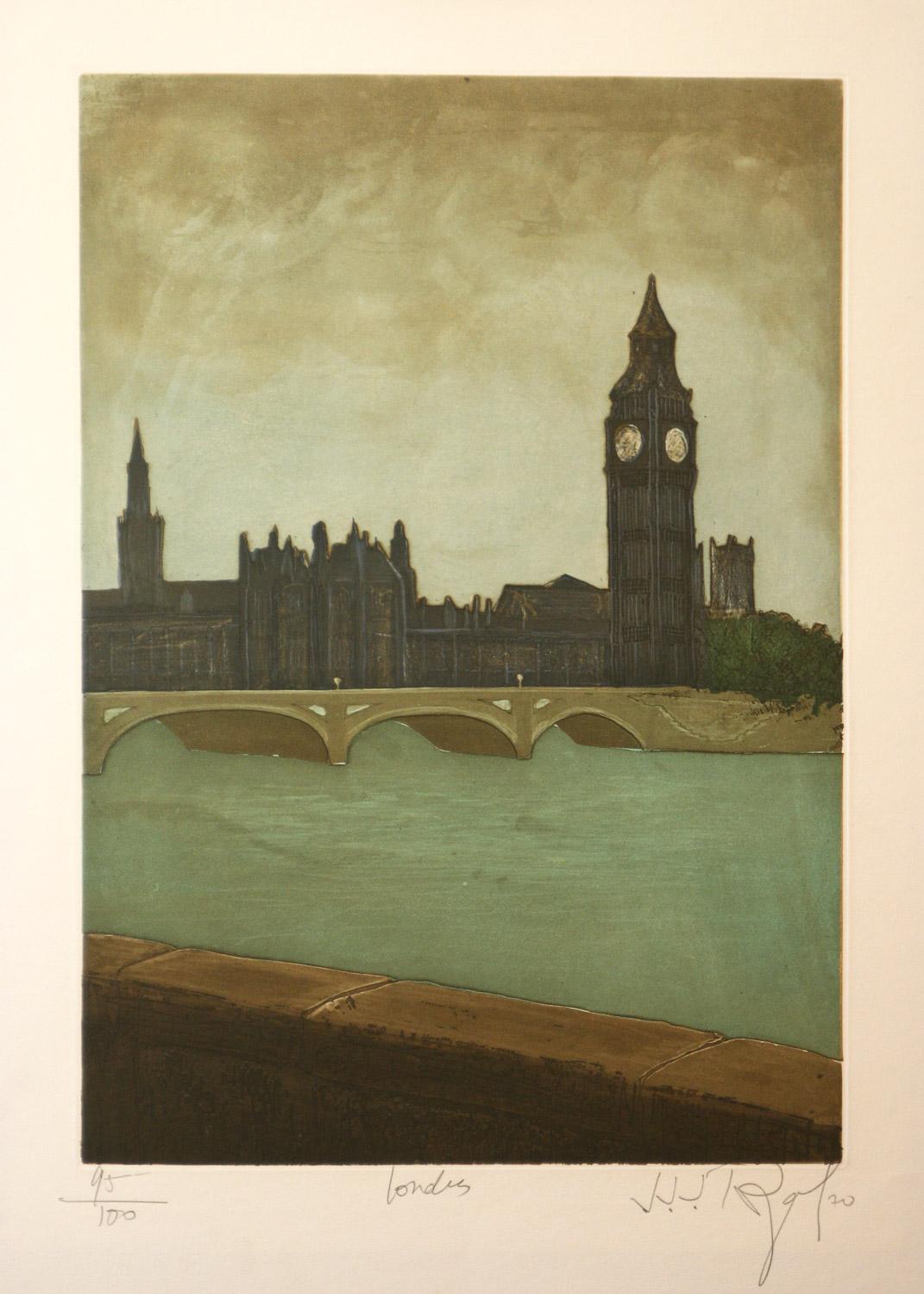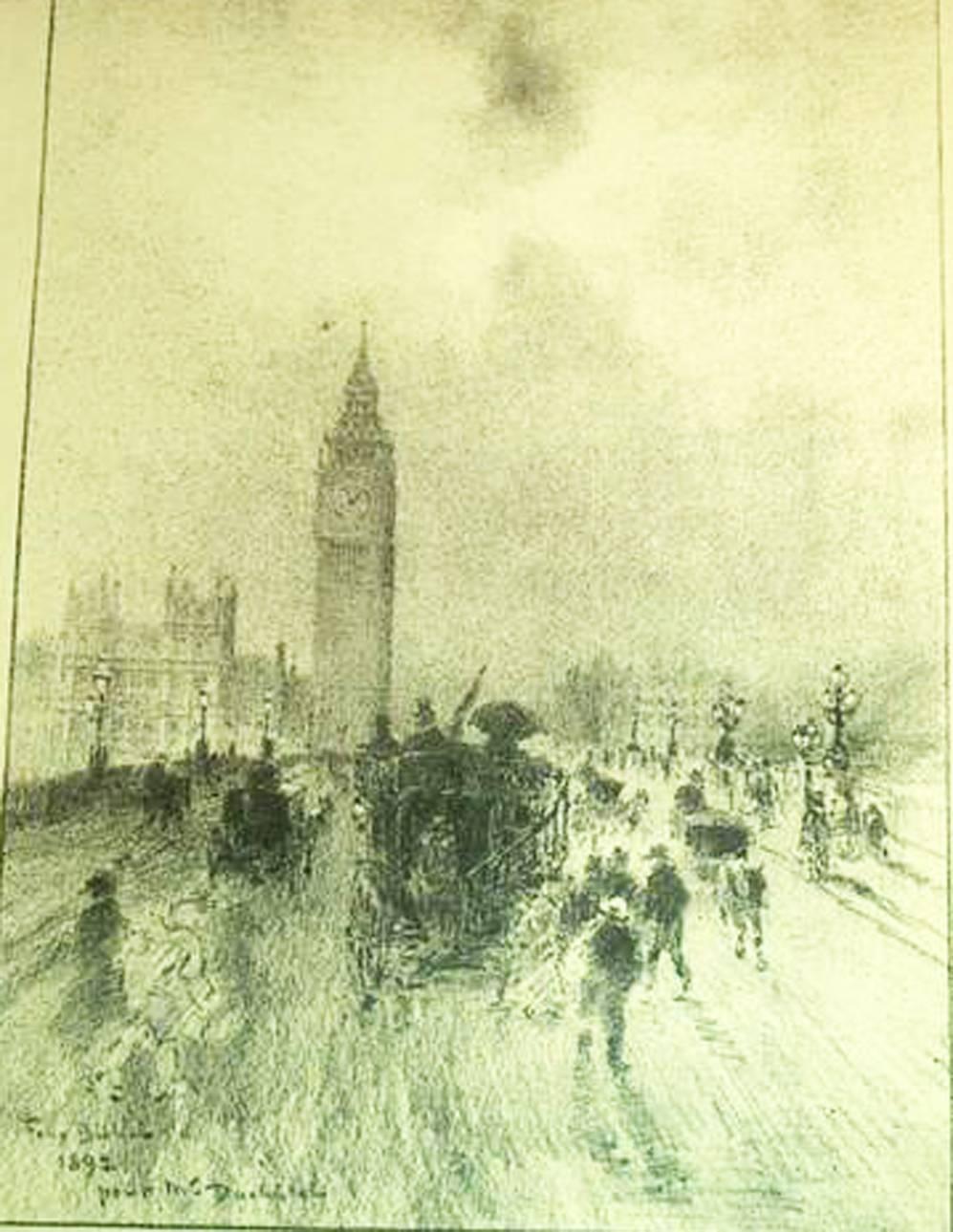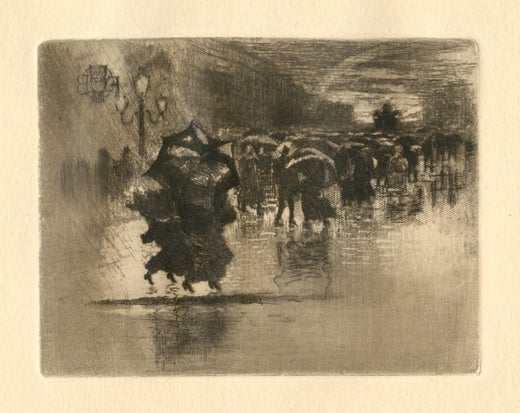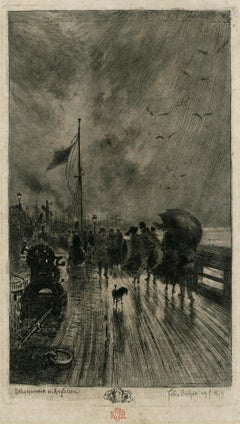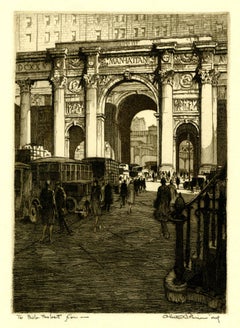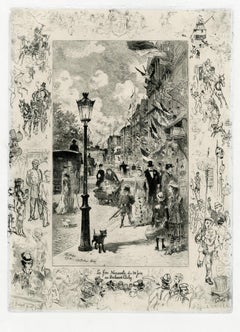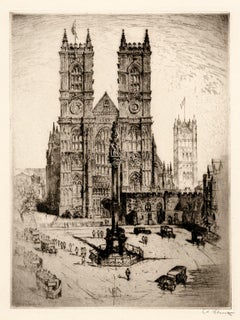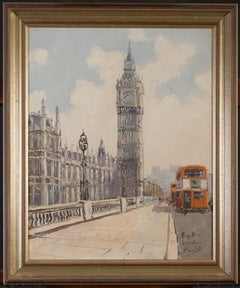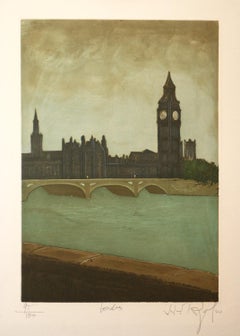Articles similaires à Palais de Westminster
Vous voulez plus d'images ou de vidéos ?
Demander au vendeur plus d'images ou de vidéos
1 sur 12
Félix Hilaire BuhotPalais de Westminster1884
1884
3 045,63 €
À propos de cet article
Westminster Palace
Etching, Drypoint, Aquatint, roulette and salt ground lift
1884
Depicts the Houses of Parliament, Big Ben Clock and Tower and the River Thames in the foreground.
Signed with the artist’s large Red Owl stamp, Lugt 977
Printed on thin wove japan, (almost parchment like) with full margins
A rich cleaned whipped impression showing burr in the central compositions, the remarques printing with atmospheric selective inking
This example is one of three depictions of Westminster that the artist created. One similar format etching and a vertical lithograph.
Condition: Excellent
Image/Plate Size: 11 7/16 x 15 5/8 inches
Sheet size: 14 1/4 x 18 3/4 inches
Reference: Bourcard/Goodfriend 155 vi/VIII, before the words "In pro..."
A rare proof
Impressions of this image are the collections of the following institutions:
Art Institute of Chicago
Minneapolis Institute of Art
Metropolitan Museum of Art
Van Gogh Museum
National Gallery of Art, Washington
High Museum, Atlanta
British Museum
Smart Museum, Chicago (canceled plate impression)
Achenbach Foundation of the Graphic Arts, FAMSF
Considered one of the artist's finest images.
Félix-Hilaire Buhot
French, 1847 - 1898
Among the most original prints made in France during the last quarter of the nineteenth century are those by Félix Buhot. Born in 1847 in the small Normandy town of Valognes, in northern France, Buhot moved to Paris in 1865, where a year later he enrolled in the École des Beaux-Arts, studying painting and drawing under various artists. Buhot first learned to etch in about 1873, producing his first etching later that year and quickly establishing himself as a successful printmaker. The young artist made his living by decorating fans and illustrating lithographic sheet music. Buhot lived and worked most of his life in Paris, with frequent visits back to northern France and extended trips to England where he met his wife, Henrietta Johnston, whom he married in 1881. By 1892 Buhot had ceased making prints, and in 1898, after suffering prolonged bouts of deep depression, he died at the age of fifty-one.
Along with Edgar Degas and Camille Pissarro, Félix Buhot numbers among the most experimental printmakers of his day. In exploring the unique aspects of etching, he developed an approach to printmaking that was very painterly; in fact he called his prints "paintings on copper." A true printmaker's printmaker, Buhot delighted in all the technical variables and regularly combined multiple processes to produce a single print: he achieved even greater tonal variation by employing the more traditional techniques of etching, drypoint, and aquatint along with several less familiar methods. Unlike many contemporary printmakers who disliked photography, Buhot heartily embraced the medium and used it as a creative aid. He also used different inks and papers for varied effects. His most original contribution to the history of printmaking is a device he termed marges symphoniques (symphonic margins): by amplifying the main subject, such illustrations became an integral part of the print.
In his many prints of city views and seascapes, Buhot was intent on creating a specific atmosphere, especially the effects of weather such as rain, snow, mist, and fog. He turned to his immediate neighborhood in and around the boulevard de Clichy in Montmartre, Paris, for inspiration for his prints of everyday city life. Buhot delighted in portraying the varied street life of the vibrant capital city not only in different seasons (Winter in Paris, 1879) but also in moments of public display, from a festive holiday celebration (National Holiday on the Boulevard de Clichy, 1878) to a somber death observance (Funeral Procession on the Boulevard de Clichy, 1887). His city views also include London scenes (Westminster Palace and Westminster Bridge, both of 1884). And Buhot's love for the sea is evidenced in the many prints exploring its ever-changing atmospheric conditions and moods. Buhot's boat trips to England inspired two of his most characteristic prints, A Pier in England and Landing in England, both from 1879.
With his experimental printmaking techniques, Buhot became one of the best-known, admired, and collected printmakers of his day. He achieved success for his prints at the annual Salons between 1875 and 1886, and a number of his works were published in leading periodicals and books. He also found critical acclaim and support for his prints in the United States, especially after his first one-man exhibition organized by the New York print dealer Frederick Keppel in 1888.
Courtesy: National Gallery of Art, Washington, D. C.
- Créateur:Félix Hilaire Buhot (1847 - 1898, Français)
- Année de création:1884
- Dimensions:Hauteur : 29,11 cm (11,46 po)Largeur : 39,71 cm (15,63 po)
- Support:
- Mouvement et style:
- Période:
- État:
- Adresse de la galerie:Fairlawn, OH
- Numéro de référence:Vendeur : FA111551stDibs : LU14014196842
Félix Hilaire Buhot
Les estampes de Buhot ont été réalisées à une époque où l'on assistait à un regain d'intérêt pour la gravure originale (en particulier l'eau-forte), qui devenait rapidement plus populaire que la gravure reproductive. Dès 1874, ses eaux-fortes ont été saluées par l'éminent critique Philippe Burty, qui a admiré les belles épreuves de l'artiste - un terme que Burty a mis en avant pour désigner des impressions rares, superbement encrées et imprimées par l'artiste lui-même. Dans les années 1880, Buhot était devenu l'un des graveurs les plus connus et les plus collectionnés de son époque. La renommée de Buhot s'est étendue bien au-delà de son pays, et il a également bénéficié d'un accueil critique et d'un soutien important pour ses gravures aux États-Unis. En 1888, le marchand d'estampes new-yorkais Frederick Keppel (1845-1912) offre à Buhot sa première exposition personnelle, qui remporte un vif succès. Outre Keppel, Buhot s'est lié d'amitié avec deux éminents collectionneurs américains de la fin du XIXe siècle qui ont amassé un grand nombre d'estampes de l'artiste : Samuel P. Avery (1822-1904) de New York a collectionné plus de 300 estampes et George A. Lucas (1824-1909) de Baltimore en a possédé environ 200. À partir de 1911, une autre grande collection a été formée par Albert H. Wiggin (1868-1951) de Boston, qui a acheté plus de 150 impressions. Aujourd'hui, ces collections se trouvent respectivement à la New York Public Library, au Baltimore Museum of Art et à la Boston Public Library.
À propos du vendeur
5,0
Vendeur reconnu
Ces vendeurs prestigieux sont des leaders du secteur. Ils représentent le summum en matière de qualité et de design.
Vendeur Platine
Vendeurs premium dont la note est supérieure à 4,7 et le délai de réponse de 24 heures maximum
Établi en 1978
Vendeur 1stDibs depuis 2013
809 ventes sur 1stDibs
Temps de réponse habituel : <1 heure
Associations
International Fine Print Dealers Association
- ExpéditionRecherche du devis...Expédition depuis : Akron, OH
- Politique des retours
Certaines parties de cette page ont été traduites automatiquement. 1stDibs ne garantit pas l'exactitude des traductions. L'anglais est la langue par défaut de ce site web.
Garantie d'authenticité
Bien qu'il soit peu probable que la situation se présente, dans le cas où vous rencontreriez un problème d'authenticité d'un article, contactez-nous dans un délai d'un an pour obtenir un remboursement intégral. DétailsGarantie de remboursement
Si votre article n'est pas conforme à la description, est endommagé pendant le transport ou ne vous est pas livré, contactez-nous sous 7 jours pour obtenir un remboursement intégral. DétailsAnnulation sous 24 heures
Vous disposez d'un délai de 24 heures pour annuler votre achat sans motif.Des vendeurs professionnels agréés
Nos vendeurs de renommée mondiale doivent respecter des normes strictes en matière de service et de qualité, afin de préserver l'intégrité de nos fiches produit.Garantie d'alignement des prix
Si vous constatez qu'un autre vendeur a mis en vente le même article à un prix inférieur sur un autre site, nous nous alignerons sur ce prix.Livraison en toute confiance à l'international
Notre réseau de transporteurs de premier ordre propose des options d'expédition spécialisées dans le monde entier, y compris des livraisons personnalisées.Plus d'articles de ce vendeur
Tout afficherUn débarquement en Angleterre
Par Félix Hilaire Buhot
Un débarquement en Angleterre
(A Débarquement en Angleterre)
Eau-forte, pointe sèche, aquatinte, roulette et terre d'esprit, 1879
Signé avec le cachet hibou rouge de l'artiste, Lugt ...
Catégorie
années 1870, Impressionnisme, Estampes - Paysage
Matériaux
Pointe sèche
Le bâtiment municipal de Manhattan
Par Chester B. Price
Signé au crayon et annoté "imp" en bas à droite ; dédicacé en bas à gauche : "A Bob Nisbet de..."
Note : Conçu par William M. Kendall de McKim, Mead et White, ce gratte-ciel class...
Catégorie
Années 1910, Estampes - Paysage
Matériaux
Pointe sèche
Fleet Street, Londres
Par Luigi Kasimir
Fleet Street, Londres
Gravure à l'eau-forte et aquatinte, c. 1936
Signé au crayon par l'artiste (voir photo)
Condit : Très bon état avec du ruban adhésif de papier brun le long des b...
Catégorie
années 1930, Estampes - Paysage
Matériaux
Eau-forte, Gravure sur bois
La Fête Nationale du Boulevard Clichy
Par Félix Hilaire Buhot
La Fête Nationale du Boulevard Clichy
Eau-forte, pointe sèche et aquatinte, 1878
Signé en bas à gauche dans la plaque (voir photo)
Chine collee imprimée, montée sur papier vélin blan...
Catégorie
années 1870, École française, Estampes - Figuratif
Matériaux
Eau-forte
Palazzo, Florence
Par Rudy O. Pozzatti
Palazzo, Florence
Eau-forte, gravure, aquatinte, fond mou et fond relevé, imprimés en couleurs à partir de trois plaques de cuivre. 1954
Signé au crayon en bas à droite (voir photo)
...
Catégorie
années 1950, Modernisme américain, Estampes - Paysage
Matériaux
Aquatinte
Le Duomo, Florence
Par Donald Shaw MacLaughlan
Le Duomo, Florence
Aquarelle, 1914
Signé et daté en bas du bord central (voir photo)
La cathédrale de Florence, officiellement la Cattedrale di Santa Maria del Fiore, est la cathédr...
Catégorie
Années 1910, Modernisme américain, Dessins et aquarelles - Paysage
Matériaux
Aquarelle
Suggestions
Palais de Westminster
Par Félix Hilaire Buhot
Felix Buhot (1847-1898), Westminster Palace, eau-forte, pointe sèche, roulette, 1884, signé au crayon et largement annoté. Bourcard/Goodfriend 155, troisième état de Bourcard (sur 5)...
Catégorie
années 1880, Impressionnisme, Estampes - Paysage
Matériaux
Pointe sèche, Eau-forte
Abbaye de Westminster" - Église royale, Londres
Par Anton Schutz
Anton Schutz, "Westminster Abbey", eau-forte, édition non mentionnée, 1927. Signé au crayon. Signé et daté dans la plaque, en bas à gauche. Une superbe impression richement encrée, a...
Catégorie
années 1920, Réalisme américain, Estampes - Paysage
Matériaux
Eau-forte
Big Ben, Westminster, Londres 1970's
Morris ou Morius, un peintre inconnu qui a du flair pour la manière extravagante et cavalière de travailler au pinceau, manifestement un artiste très expérimenté et sûr de lui, qui ...
Catégorie
années 1970, Peintures - Paysage
Matériaux
Huile, Planche
Gravure à l'aquatinte originale signée à Londres, Angleterre par J.J. Regal
Londres, Angleterre est une aquatinte originale signée à tirage limité. gravure de l'artiste français J.J. Regal imprimé sur du papier BFK Rives. Il s'agit d'un design très auda...
Catégorie
20ième siècle, Expressionniste, Estampes - Paysage
Matériaux
Eau-forte
Aquarelle du milieu du 20e siècle - Maisons du Parlement depuis Whitehall Court
Une vue charmante des Chambres du Parlement depuis Whitehall Court au crépuscule. Inscrit avec la localisation en bas à droite. Signature illisible. Présenté dans un cadre doré. Sur ...
Catégorie
20ième siècle, Dessins et aquarelles - Paysage
Matériaux
Aquarelle
212 �€ Prix de vente
20 % de remise
THE VICTORIA CLOCK TOWER, LONDRES
Par Félix Hilaire Buhot
Buhot, Felix. LA TOUR DE L'HORLOGE VICTORIA, LONDRES. BG 184. Lithographie, 1892. image : 230 x 163 mm ; feuille : 381 x 279 mm. Signé dans la pierre "Felix Buhot 1892 pur M. Duchate...
Catégorie
Années 1890, Estampes - Paysage
Matériaux
Lithographie
